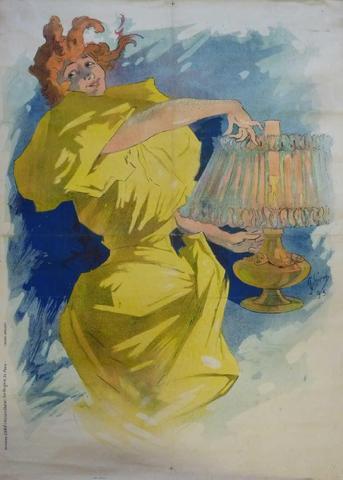
|
|
Saxoléine
Broido 954
lithographic
poster
in four colours, 1895, a rare first state impression, before letters,
the registration marks showing clearly above and below, a slight
horizontal discharge of ink across the lower dress and base of the
lamp, horizontal and vertical folds apparent, a few short marginal
tears (notably upper left and bottom), some minor cuffing of the sheet
edges, expertly backed on linen, otherwise in relatively fine
condition (Condition B+)
This exceptional poster is considered to be one of Chéret's best,
"Cheret
produced a wide variety of posters for Saxoleine paraffin (lamp oil).
All of them show in endless variations the vivacious 'femme de Paris'
in a graceful pose. This poster is one of the best"
-- Hermann Schardt, Paris 1900, 1970:98.
and the the colours here are singularly fresh and vivid.
L. 1230 x 860 mm. S. 1250x890 mm.
Provenance: a private
French collection
|
Jules Chéret and his innovative lithographic art were widely acclaimed in his time. In 1889, he won a gold medal at the Exposition Universelle in Paris, and the following year, he was knighted in the Légion d'Honneur for being the:
"Créateur d'une industrie d'art depuis 1866 pour l'application de l'art à l'impression commerciale et industrielle."
[Creator of an art industry since 1866 in applying art to commercial and industrial printing.]
Throughout the 1890s, Jules
Chéret created over a dozen posters for Saxoléine paraffin lamp oil,
establishing a clear paradigm for the brand's identity, never showing
the product itself (sold in 5-litre cans), but rather the warm
gratification of convenient household lighting, embodied by a gay Chérette in a swirl of refined colour.
Technically speaking (given that printing each colour required a separately prepared stone), the
most interesting aspect of Chéret's lithographic style is the economy
of only four colours (ultramarine blue for the keystone, pale cyan
blue, red, and yellow). The flat colour fields are overlaid with fine chromatic gradations and textured wash to obtain maximum visual effect.
A veritable tour de force!
... and the product is still marketed today!

(Cf. the published version of
this poster in the Bibliothèque nationale de France at:
http://catalogue.bnf.fr/ark:/12148/cb398366806)


